
The Windsor Avenue Congregational Church is historic church at 2030 Main Street in Hartford, Connecticut. The brick Romanesque Revival-style church building, completed in 1872, now houses the Faith Congregational Church, whose lineage includes the city's oldest African-American congregation, established in 1819. The church is a stop on the Connecticut Freedom Trail and was listed on the United States National Register of Historic Places in 1993.

The Jacob Pledger House is a historic house at 717 Newfield Street in Middletown, Connecticut. Built in 1803, it is one of only five surviving brick Federal style houses in the city. It was listed on the National Register of Historic Places in 1982. It now houses professional offices.

Hartford Union Station is a railroad station in Hartford, Connecticut, United States on the New Haven–Springfield Line. It is served by Amtrak Hartford Line, Northeast Regional, Valley Flyer, and Vermonter intercity rail service, plus CT Rail Hartford Line commuter rail service and CTfastrak bus rapid transit service.

The Harriet Beecher Stowe House is a historic house museum and National Historic Landmark at 73 Forest Street in Hartford, Connecticut that was once the home of Harriet Beecher Stowe, author of the 1852 novel Uncle Tom's Cabin. Stowe lived in this house for the last 23 years of her life. It was her family's second home in Hartford. The 5,000 sq ft cottage-style house is located adjacent to the Mark Twain House and is open to the public. It was listed on the National Register of Historic Places in 1970, and declared a National Historic Landmark in 2013.

The McLellan-Sweat Mansion is a historic house museum on High Street in Portland, Maine. It forms the rear component of the Portland Museum of Art complex. Built in 1800–01, the house was designated a National Historic Landmark in 1970 as a well-preserved Federal style brick townhouse.
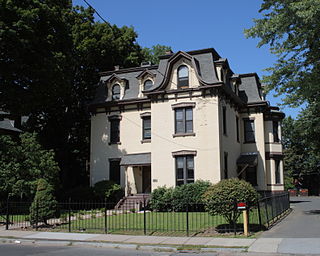
136–138 Collins Street is an architecturally distinguished Second Empire house in Hartford. Built about 1870, it is a rare and well-preserved example of this style in the city. It was listed on the National Register of Historic Places on April 29, 1982.

The Daniel Hosmer House is a historic house at 253 North Main Street in West Hartford, Connecticut. Built about 1774, it is one of the town's small number of surviving 18th-century buildings, and is a well-preserved example of a Georgian farmhouse. The house was listed on the National Register of Historic Places on September 10, 1986.

The Butler-McCook Homestead is a historic house museum at 396 Main Street in Hartford, Connecticut. Built in 1782, it is one of the city's few surviving 18th-century houses. It was listed on the National Register of Historic Places in 1971. It is now operated as the Butler-McCook House & Garden by Connecticut Landmarks.

The house at 36 Forest Street, sometimes called the Burton House in Hartford, Connecticut, United States, is a wooden Shingle Style structure built in the late 19th century and largely intact today. It was listed on the National Register of Historic Places in 1983.

83–85 Sigourney Street in Hartford, Connecticut was an Italianate style double brick house. Built in 1865, it was the oldest surviving residential building on the southern part of Sigourney Street in the city's Asylum Hill neighborhood. It was listed on the National Register of Historic Places in 1979, at a time when there were no known threats to the building. A modern building, housing the former Connecticut Culinary Institute, was built on the site in 1981 and now stands at 85 Sigourney Street; it is the Hartford campus of the Lincoln Culinary Institute, and is part of the Lincoln Group of Schools.

49–51 Spring Street in Hartford, Connecticut is a significant local example of Richardsonian Romanesque residential architecture. It was built about 1890 for the locally prominent Allyn family. It was listed on the National Register of Historic Places in 1983.
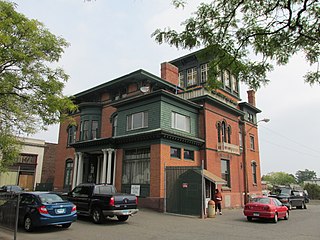
The Lucius Barbour House is a historic house at 130 Washington Street in Hartford, Connecticut. Built in 1865, it is a high-quality local example of Italianate architecture executed in brick. It is also noted for its interior, which is a well-preserved later Victorian remodeling of the original. The house was listed on the National Register of Historic Places in 1979.

The Boce W. Barlow Jr. House is a historic house at 31 Canterbury Street in Hartford, Connecticut. An architecturally undistinguished two-story built in 1926, it was from 1958 home to Boce W. Barlow Jr. (1915–2005), the first African-American to win election to the Connecticut State Senate, and a prominent figure in Hartford politics. The house was listed on the National Register of Historic Places in 1994.

The Day-Taylor House is a historic house at 81 Wethersfield Avenue in Hartford, Connecticut. Built in 1857, it is one of state's best examples of Italianate villa architecture executed in brick. It was listed on the National Register of Historic Places in 1975. It presently houses offices.

The Isham-Terry House is a historic house museum at 211 High Street in Hartford, Connecticut. Built around 1854, from 1896 it was home to members of the Isham family, who restored it in the early 20th century. The family donated the property to Connecticut Landmarks in the 1970s, which now operates it has a museum, offering guided tours and facility event rentals. The house was listed on the National Register of Historic Places in 1982.
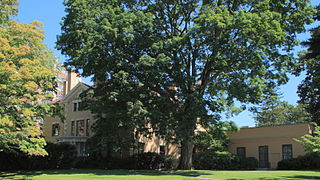
The Lyman House is a historic house at 22 Woodland Street in Hartford, Connecticut. It was built in 1895 for Theodore Lyman, a prominent local lawyer and corporate director. Since 1925 it has been home to the Town and County Club, a private women's club. A well-preserved example of Classical Revival architecture, it was listed on the National Register of Historic Places in 1975.
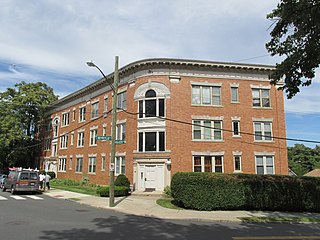
The Myers and Gross Building is a historic apartment building at 2 Fraser Place in Hartford, Connecticut. Built in 1917, it is a well-preserved example of Georgian Revival architecture. It was listed on the National Register of Historic Places in 1983.

The Henry Magill House is a historic house at 390 Palisado Avenue in Windsor, Connecticut. Built in 1861, it is a well-preserved and locally rare example of Second Empire architecture executed in brick. It was listed on the National Register of Historic Places in 1988.

The Spencer House is a historic house at 1039 Asylum Avenue in Hartford, Connecticut. Built in 1929 for a bank chairman, it is one of the last grand houses to be built in the city's Asylum Hill area, and is a good example of Georgian Revival architecture. It was listed on the National Register of Historic Places in 1983.
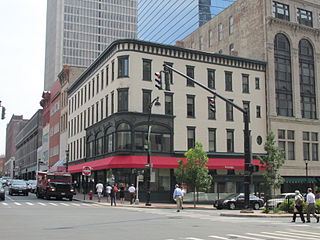
The Stackpole, Moore, and Tryon Building is a historic commercial building at 105-115 Asylum Street in downtown Hartford, Connecticut. Built in the mid-19th century, and extensively altered in 1896, it is a good local example of a period building with a Beaux Arts cast-iron facade. It was listed on the National Register of Historic Places in 1978.






















